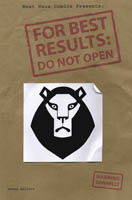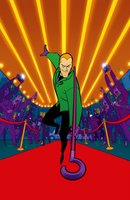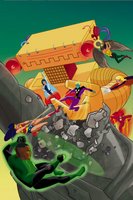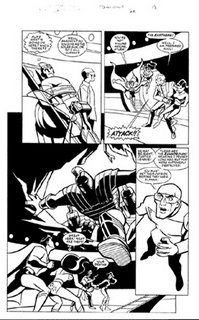[Interview for
Toon Zone News: 2nd January 2004]
Following last month's in depth look at penciller Christopher Jones' artwork for Justice League Adventures #25, Toon Zone offers another exclusive look behind the scenes at the title.
Toon Zone: Let's look at some of the pages from the current issue of Justice League Adventures #26 (out now) before moving on to previews of the next issue.
TZ: We have a fair amount of circular line work in the above page. How do you work with curves? Do you use any specific tools and how do you apply them?
Jones: Templates and french curves are your friends. I have a variety of templates for circles and elipses and consider them indispensable. I even take a couple with me when I go to a convention where I'll be doing sketches. You never know when someone's going to ask you to draw Captain America!
TZ: Dan, as inker, the same question to you. What method to you use to maintain the curves in Chris’ pencils?
Dan Davis: Curved lines are always a bit of a challenge, but I have several approaches. The large curved lines can either be done freehand with a brush, but this takes quite a bit of practice and control. A more surefire way is to use a french curve flat on the paper and ink as far as you can go without repositioning the curve. Then try to get a seamless line and continue the curve. You can use a finepoint marker or technical pen if you want to go right up against the edge of the french curve.
To give the ink line more life and vary the thickness a little you can raise the french curve by taping pennies underneath and ink with a crowquill pen. This takes a little practice but is worth mastering. I don't use pennies anymore. I simply hold the edge up about a quarter of an inch and steady it with my hand against the paper. Then I can run the crowquill along the edge without fear of the ink smearing underneath.
TZ: Christopher, do you find repetitive character designs in a script something you welcome or do you find them tiresome? For instance, we see a great many facial shots of Batman in this issue, all of which I imagine are pretty straightforward for you, considering how masked his features are. Do you get tired of drawing masked characters, or do you appreciate the simplicity they bring to drawing a panel?
Jones: Well, Batman is darned fun to draw. I actually find it a fun challenge to keep him interesting to look at if he's standing around and talking a lot. His expressions tend to be pretty minimalistic in those scenes, so I try to create the feeling I want with how he's positioned within the panel frame. He's also a great character to draw in partial silhouette.
TZ: The last three panels of this page are very intense so far as visually depicting action, especially the middle one. In regards to space, was this is hard page to construct?
Jones: You just try and break it down as to what's important to communicate. The last three panels form a sequence where the cave roof starts to collapse, the Martian Manhunter shapeshifts back to his normal shape to fly up through a newly-created opening, and the last panel shows him on the surface, looking down through the narrow gap he flew out of. Once I decided that the best way to show this action was with three tall, narrow panels in a row (to help emphasize the vertical action lines), it came together pretty easily.
TZ: Going back to a subject we talked about in the last interview -- lettering. We have some more visually exciting letter work on this page. Did you have any particular training in lettering? Do you use any particular equipment to letter sound FX?
Jones: The trick with the sound effects is you never know from looking at the finished page whether a given sound effect is the penciller's doing or not. I usually pencil the sound effects that I want -- it lets me incorporate them into the overall composition of the panel. Sometimes that lettering gets inked pretty much as I drew it. Other times, the letterer alters it a bit, though it usually stays fairly close to what I had pencilled. I don't think you always need to have a sound effect -- sometimes I'll intentionally not put one in -- and often I'll see the finished comic to find that one has been added anyway.
TZ: Dan, we have some pretty large areas to filled on this page. How much ink do you go through generally as an inker?
Davis: I really don't know how much ink I use per issue. I would say less than a one ounce bottle per issue for sure. I would guess a bottle lasts a couple of issues at least! Even for an artist like Chris who uses so many black areas -- and uses them well I might add.
TZ: Looking at the gun on the above page: how do you approach props? As with Adam Strange story -- based on Rann rather than Earth -- how do you work with sci-fi props? Are they based on any real objects?
Jones: You draw inspiration from different places. When drawing real places and things, I work pretty hard to find reference material to allow me to draw them accurately. When making up fantasy props and locations for an alien world or something, you still try to give them a feeling of reality. I find that if I give a little thought to a prop's function and try to design it with a bit of thought toward how it's supposed to look, it comes out looking better than if I just tried to make it look "cool."
TZ: How do you deal with props in general?
Jones: If it's something that's going to appear in a story a lot, I try to work out the design before I start drawing the actual pages. That's part of the first step I go through when I get a new script to work on -- read it and identify characters and props that need to be designed before I can start drawing page 1.
TZ: Why did you choose such a simple panel format for this page? Was there a reason behind this?
Jones: I try not to go too crazy with panel layout on this book in general, as DC likes to keep the art as simple and clean as possible. I see panel layout as one of the tools in my arsenal to create different moods and tensions as I tell the story. If you use every crazy layout style you can
think on every page, you don't have anything left for when you want to create a sense of shock or unease.
As for this page specifically, there's a lot of cutting back and forth between Sardath inside and the battle with the Ranndroids outside -- every other panel in fact. Having the panel shapes be uniform seemed the best way to cut back and forth and not have it get too distracting or confusing.
On to issue 27 of Justice League Adventures (out 7th January 2003)
TZ: Let's now have a sneak peak at the artwork for issue 27.
First off, we have all the Justice League thrown into one mighty visual. Were you working from a scripted story, or, like the previous two issues, were you working more on a less linear format?
Jones: Well, this issue was from a full script, as most of my work for DC Comics is. Issues #25 and #26, being drawn from a plot, were something of an anomaly. The script for this issue was by Josh Siegal, who had written the Martian Manhunter story for #10, and who also wrote a fantastic Phantom Stranger story that's coming up in a few months.
TZ: Did you have free reign on the specific actions of each character?
Jones: I think I had a little leeway in figuring out the specific actions of the League members in this shot. The main point was to have them fighting a giant robot. One of the actions that was specifically indicated was to have Hawkgirl saving bystanders rather than fighting the robot directly. This was important since the people she is telling the story to begin to question her effectiveness in battle next to the likes of Superman and Wonder Woman.
TZ: Do you find the more intricate one-image pages more or less difficult to finish than those with a sequential panel element?
Jones: It was probably a little more time consuming than some sequential panel pages. But sometimes those can get equally busy with detail or time-consuming to design.
TZ: When doing city shots like this, you have to be prepared to do what could be considered as pretty monotonous repetition -- for example, the intricate building on the left. Do you find it hard to concentrate on such repetitious design or is it something you enjoy?
Jones: If I was doing a lot of that sort of thing it could get kind of old. But doing a bunch of perspective work or something can be a welcome change of pace from a lot of body shapes or dialog scenes. Variety helps keep thing interesting.
TZ: In this page and throughout your work, you seem keen to explore different visual perspectives. Are there any angles you find more difficult than the rest? Do you look for visual approaches that test you as an artist or ones that you feel complement the script?
Jones: I find that changing the "camera angle" keeps the page looking more interesting, especially when doing a scene that is more dialog-driven and has little action in it.
Some of the first work I did for DC was on a title called Young Heroes in Love. There was a character in that group called Junior who was tiny -- around the size you usually see the Atom -- only he couldn't change size, he was just stuck that way. I always used to like doing shots focused on him, that made the other characters look like giants looming over him. I thought that sort of thing worked well for the character and helped keep the story interesting visually. That's the kind of thing I'm thinking about a lot when I'm designing a page.
TZ: Looking at the buildings! What research to you do when it comes to outside shots? Or do you work simple from you imagination?
Jones: It's a combination of imagined locales and ones taken from photographs. I find that basing locations on reality keeps me from falling into the trap of generic comic book locations -- cityscapes that look like shoeboxes with crossword puzzles taped to them and that sort of thing.
TZ: What advice would you give to artists trying to create exterior environments? In a confined panel, how do approach giving the illusion of space and season?
Jones: I always tell artists just starting out the same thing regarding characters and backgrounds: Look at reality. Whether it's looking at a photograph or looking at a live model sitting in front of you, it's important to start with how things look in the real world. A lot of bad comic book art has been produced by artists that seem to have learned to draw by looking at other comic books and took away all the wrong lessons. They end up drawing abstractions of abstractions.
The best trick I know of for creating an illusion of depth is forced perspective. If you think of having multiple planes of depth in a single image -- a foreground, a middle ground, and a background -- you can place things in each field that have a recognizable scale to them. By having small objects large in the foreground and large objects small in the background it really forces the reader to create an illusion of depth in their mind. It sounds simple, but it works!
TZ: Despite having to keep to the angular vision of the series, you seem to keep a fluidity to the characters. The first panel in particular seems a good example of this. Do you work from real life studies outside your comic work? As a comic illustrator, how important are real life drawings to your work?
Jones: It's funny, I didn't start out drawing like Bruce Timm. You could debate how successfully I do it when I try!
I've done a lot of work in other, more "conventional" art styles, and that definitely figures into my work on this series, even when I'm trying to draw the characters "on model" for their animated series designs. Furthermore, I feel like the more I can keep the backgrounds realistic-looking and full of life, the more it grounds these potentially cartoony-looking characters into a sort of reality.
TZ: We have 8 panels in this sequence, all with several characters. There seems to be a lot of information to gather and visualise here. What are the dangers when composing such a layout? How do you prevent it getting too confusing?
Jones: Thankfully the drawing style for this book allows for character designs that are simple and clean enough that it helps small panels from feeling too cluttered. Beyond that, you just try to do panel compositions that are very clear and reinforce the action you want to convey. Notice the way the bald character (Joe) is complaining to Hawkgirl. When she verbally smacks him down, I have her lean in to practically force him out of the panel. When he walks away past the rest of the group to sit in a chair and sulk, I tried to use the panel shapes to make him more isolated as he carries through with this action. I think it worked pretty well.
TZ: This issue has quite a few characters. Some are background roles, some are minor ones, and of course we have the main characters. When you have many characters for an issue, how do you approach them and in what different ways do you have to treat different characters?
Jones: This story features a number of young characters who have superpowers and are hoping to go on to be superheroes. But they're young and not yet ready (because they weren't taken in to be trained by Batman, I guess). So I wanted to give them a variety of facial and body shapes so they were distinct from each other, but also to make sure they looked young and that none of them were as big and impressive as even the slightest League members, who I guess would be Hawkgirl and the Flash.
TZ: Let's look at some of the model sheets you did for the guest characters for this issue. First we have Pandora and Joe. In regards to the young and not-quite-ready look to the new superheroes, Pandora and Joe stand out as unusual designs. Could you tell us a little about how you decided on their designs? How much of the design is yours and how much is the writer's? Pandora's design is particularly refreshing so far as heroes go.
Jones: Josh had some rough descriptions of how he wanted the characters to look. None of them were to have what looked like "professional" superhero costumes. Pandora's look as seen in this design actually got tweaked for use in the story. We gave him a T-shirt underneath his button-down shirt to make his look even more casual, and because I had the idea of giving him a shirt with DaVinci's "Proportions of Man" design on it, which is a bit of a visual joke given his power to project force field boxes. The things on his wrists changed as well, because I was a dunce and initially misunderstood their description.
TZ: Tell us a little bit about the evolution of the Psion design for this issue.
Jones: Well the script called for the Psions, a race from the DC universe with some history. Given that this was their first appearance in the animated universe, I saw this as an opportunity to revise their look a little, much like the designers for the TV show do when they bring in characters from the comics.
I felt that the existing comic book version of the Psions was a little plain -- average-looking guys with Star Trek-style ridges on their heads. I didn't want to alter the Psions so radically that they didn't seem like the same race, but I did alter their proportions a bit -- enlarged heads, smaller bodies. And I exaggerated the existing ridge pattern on both their heads and clothing to tie them in to the existing design. I'm pretty happy with the final result.
Toon Zone would like to thank both Christopher Jones and Dan Davis for kindly providing scans of their artwork to complement this interview.
Justice League Adventures#26 is still in the shops, Justice League Adventures #27 is out on the 7th January.
Interview Copyright: James McLean
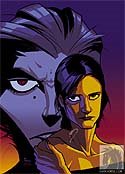 Along with Star Wars Tales artist Sean Murphy, CRUSH takes us into the deeply confusing life of a young teenage girl who has to come to terms with the monster that lurks within her.
Along with Star Wars Tales artist Sean Murphy, CRUSH takes us into the deeply confusing life of a young teenage girl who has to come to terms with the monster that lurks within her. 

